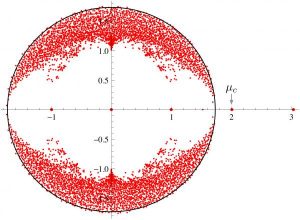Systèmes désordonnés
– Les systèmes désordonnés apparaissent naturellement dans la physique de la matière condensée. Les matériaux amorphes tels que les verres et les verres de spin en sont des exemples. À l’IPhT, une importante activité de recherche vise à comprendre la nature et les propriétés des solides amorphes à basse température en combinant la résolution de modèles de verre en dimension infinie, des simulations numériques et des expériences. Les modèles d’intérêt comprennent par exemple les systèmes colloïdaux et granulaires, les sphères dures ainsi que les modèles de particules non-sphériques. La rhéologie des solides amorphes est également étudiée en développant des approches théoriques pour décrire la transition d’élasticité. Un autre sujet est l’étude des excitations à basse énergie des systèmes amorphes. Enfin, la théorie des grandes déviations sont utilisées pour décrire les événements typiques et rares qui se produisent à différentes échelles spatiales et temporelles dans les systèmes désordonnés. Parmi les exemples d’applications, on peut citer les phases vitreuses des modèles de pièges aléatoires, l’inférence à partir de longues marches aléatoires dans les milieux désordonnés, les modèles cinétiquement contraints, ou les exposants de Lyapunov de taille finie dans les modèles de localisation d’Anderson.
Applications interdisciplinaires de la physique statistique
– Des outils théoriques ancrés dans la physique des systèmes désordonnés sont appliqués à des problèmes d’optimisation en haute dimension. Une ligne de recherche vise à comprendre les propriétés des algorithmes d’optimisation basés sur la descente de gradient pour résoudre les problèmes d’inférence en grande dimension. Dans le même temps, la théorie du champ moyen dynamique est utilisée pour étudier l’algorithme stochastique de descente de gradient, qui est une méthode centrale dans le domaine de l’apprentissage profond. Cela permet de comparer les performances de cet algorithme dans des contextes typiques d’optimisation non convexe en haute dimension. Les problèmes de transport optimal et leurs liens avec les problèmes informatiques sont étudiés à l’aide de méthodes de physique statistique. Les applications de la physique statistique aux problèmes de biophysique sont également étudiées. En outre, des approches théoriques et algorithmiques sont développées pour étudier la structure des protéines et les chemins de transition entre leurs états. Les outils des systèmes désordonnés sont également appliqués à l’étude des stratégies d’apprentissage dans les réseaux neuronaux récurrents et, plus généralement, dans les systèmes chaotiques de haute dimension. Enfin, une ligne de recherche est développée pour décrire la croissance des villes à l’aide d’outils théoriques de physique statistique et de processus stochastiques.
Chercheurs permanents
Marc BARTHELEMY
Pierfrancesco URBANI
Cecile MONTHUS
Henri ORLAND
Jean-Marc LUCK
Claude GODRÈCHE
Bertrand DUPLANTIER
Laura FOINI


